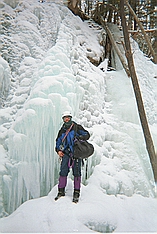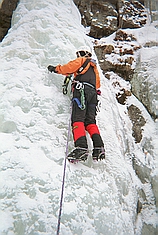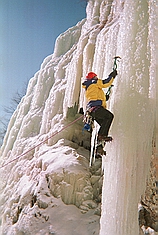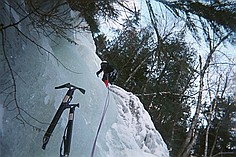Home
Page | Climbing
Page | Photo
Page | Travel
Page | Writing
Page
 Surfing in Kansas Surfing in Kansas
A beginner's look at
Adirondacks ice climbing
(for Tuan's Cold Mountain Page)
Being a climber in the Washington D.C. area is becoming
ever
more difficult. With the closest multi-pitch route over 150 miles away
and with the local crags full of people who talk like living gear
encyclopedias and feel like they have to bring every person they ever
met to climb, ice climbing appeared to be the only way out. So, after
nagging my only ice climbing friend for months and having spent all my
disposable income on ice gear, Gregg Esenwein and I set out for the
Adirondacks in upstate New York.
On our way up, I was really hoping that I would not be
in over my head. I had always felt intimidated by the small number of
ice climbers in Washington and by the appearance of misery that the
stories in magazines and books depicted. Furthermore, I think it is
against some physical
law for a Puertorican to get involved in a sport where water does not
appear in liquid state. But as you are about to see, ice climbing can
be
a fun extension of our sport which allows for the enjoyment of those
days
too cold for adventuring into the rocks.
The drive to the Adirondacks is brutal by any
standards: 535 miles or nine hours if you have accumulated too many
tickets on past road
trips. Like Gregg says, "being an ice climber in Washington is like
being a surfer in Kansas!". But wanting it bad enough to endure Gregg's
Neil Young CD collection, we were at the outskirts of the Adirondacks
State Park by days end.
On the first night, we stayed in a motel some 70 miles
south of
Keene Valley along Interstate 87. The plan was to recuperate from the
long
drive, wake up early, and hit the beginners' climbs in the Chapel Pond
area
before anybody else got there (Gregg is very conscious of spectators
while
he is leading ice). At dawn, we cleaned the room, geared up in proper
attire, and embarked on a search for ice while listening to Green Day.
 The first project of the day
was the Dix Pond Trail Head (WI 2 - 2+). The small waterfall is
visible on the east side
of Route 73 with convenient roadside parking available a few meters
ahead.
We cramponed on the side of the road and bush-whacked about 30 meters
to
the ice. The main waterfall rises about 6 meters and is followed by
some
40 meters of low angle ice. Gregg placed a couple of screws and took a
fall when one of his crampons came off his boot. I held him in place,
and
he managed to put it back on and finish the climb. He set a top rope
anchor, and it was time for me to finally test all my book-acquired
knowledge and my brand new ice tools. The first project of the day
was the Dix Pond Trail Head (WI 2 - 2+). The small waterfall is
visible on the east side
of Route 73 with convenient roadside parking available a few meters
ahead.
We cramponed on the side of the road and bush-whacked about 30 meters
to
the ice. The main waterfall rises about 6 meters and is followed by
some
40 meters of low angle ice. Gregg placed a couple of screws and took a
fall when one of his crampons came off his boot. I held him in place,
and
he managed to put it back on and finish the climb. He set a top rope
anchor, and it was time for me to finally test all my book-acquired
knowledge and my brand new ice tools.
It had snowed during the week preceding our visit, so
the ice was a bit rotten. I was surprised to see that things were
working like the books had said they would. I was making good tool
placements (even though big chunks of rotten ice were coming off all
over the place), and I was
keeping my weight over my feet. I had not banged my knuckles yet, and
although the temperature was about 5°F, the combination of
underwear, fleece, and shell felt toasty warm. Upon my descent, Gregg
jumped back on, climbed back to the anchor, and finished the pitch over
some slabby ice (WI 1). Following him gave me an opportunity to
practice my French technique, and after rappelling the pitch, we
decided to move along.
After having some beef jerky (which helps explain why
my stomach is ruined), the afternoon took us to the Practice Wall
(WI 3). This is a collection of climbs (50 meters wide) located about
half a
kilometer north of Dix Pond Trail Head on the east side of
Route
73. In this area there is no parking, but the shoulder is wide enough
to accommodate cars safely. Gregg led a couple of the routes and placed
top ropes for me to practice on. The ice formations in this wall were
among the most spectacular that we saw. Bulges protruded from bulges
looking
like a complex and grotesque giant mushroom field. After doing seven
pitches
each, we called it a day and headed north towards Keene.
Along the way, we stopped at The Mountaineer to browse and
talk
some climbing. The store, which is a good place to obtain route finding
information and to rent gear, holds an impressive inventory of
equipment. The staff was knowledgeable and friendly.
In apparent violation of the laws of thermodynamics,
clothing and gear becomes soaking wet while climbing ice. This makes
the desire for civilized shelter strong and forced us to drive to the
Cascade Lake area where we arranged for lodging in a roadside motel
named Fairview. The owner, a German lady, was most helpful, and her
influence gave the place the appearance of a typical pension in the
Alps. I spread the ice-stiffed ropes along
the floor and hung the crampons and the ice rack in the shower.
Meanwhile,
Gregg hung his down jacket and other items which had frozen solid after
a bottle of Gatorade spilled inside his pack. Plagued by hunger, we
drove
to Lake Placid were we had some dinner, called the wives, and purchased
some beer before returning to the motel. Back in the motel, Gregg
worked
on adjusting his crampons, and I patched the numerous crampon-rips in
my
pants using duct tape.
 The next day, we headed to
the Cascade Lake area (between Keene and Lake Placid on Route 73). At
8:15 am, we were the second party to arrive at Pitch Off Right
(WI 2 - 4+). This wall of ice, which is across the lake from Green
Gully, contains numerous routes which can satisfy climbers at just
about any level. The routes, which can be led or top roped, are up to
25 meters in length, and the ice formations contain bulges, corners,
pinnacles, and even caves. The arrangement of the routes is very
similar to that in the main climbing area at the Gunks, NY, with the
routes decked by an iced walkway that leads to a steep approach and the
road bellow. Due to this terrain, it is good practice to be tied in at
all times. During the four hours that we spent there, I saw my pack and
two helmets roll down the hill all the way to the road, and two people
wiped out which almost ruined my day. The next day, we headed to
the Cascade Lake area (between Keene and Lake Placid on Route 73). At
8:15 am, we were the second party to arrive at Pitch Off Right
(WI 2 - 4+). This wall of ice, which is across the lake from Green
Gully, contains numerous routes which can satisfy climbers at just
about any level. The routes, which can be led or top roped, are up to
25 meters in length, and the ice formations contain bulges, corners,
pinnacles, and even caves. The arrangement of the routes is very
similar to that in the main climbing area at the Gunks, NY, with the
routes decked by an iced walkway that leads to a steep approach and the
road bellow. Due to this terrain, it is good practice to be tied in at
all times. During the four hours that we spent there, I saw my pack and
two helmets roll down the hill all the way to the road, and two people
wiped out which almost ruined my day.
While we took turns on the top rope in a collection of
WI 3 and
3+s, a couple of Canadian parties instructed some of their members.
Meanwhile Greg Byam from
Chatham, NJ, led a couple of WI 4 and 4+ routes while trying to teach
his partner to belay. With ten pitches (each) under our belts, and just
having listened to Byam's belayer respond "On rappel!" to Byam's
question "Belay on?", we decided it was time for us to leave before we
saw blood stain the ice.
We got back in the truck and drove to the parking spot
at the end of the lake. There, we walked across the lake and started up
one of
the unlisted gullies at the base of the ridge on the shore of the lake.
This gully, named Pedro's Gully (WI 1 - 2+) by Gregg, is
not in every year according to some locals. The climb alternates
between
4 meter waterfalls and flat stretches of ice. The forest surrounding
the
gully gives it a sense of wilderness not found in the other climbing
areas
while providing great protection. A bit of bush-whacking was involved,
but after four pitches we found ourselves almost at the top of the
ridge
with a spectacular view of the lake area.

Upon rappelling down the gully, we went in search of
other unlisted climbs in the west side of the Cascade Lake area. We
found two additional gullies, one of which looked to be about WI 3 for
about 150 meters of majestic deep blue ice. We agreed to give it a try
first thing in the morning and headed towards the truck across the
frozen swamp at the north end of the lake. There we both learned an
invaluable lesson: swamps take much colder temperatures to freeze than
lakes. Halfway to the truck, the ice started creeping under my feet and
next thing I knew, I was up to my calves
in a brown, smelly, slimy substance. Gregg fell through too, and as I
tried
to get out, the top ice kept on breaking. Stinking, exhausted, and
hungry,
we walked back to Pedro's Gully and crossed the lake where we
had come in four hours earlier.
We decided to have dinner at a small restaurant in the
town of Keene. On the way back to the motel, we picked up the mandatory
beer, reported to the War Department (i.e., the wives), and I
bought yet more beef jerky (I guess to annoy Gregg more than to feed
myself). In the motel, the enduring and tedious task of gear drying and
pants patching drained the last bit of our energy.
The next day, sore, with swelling knuckles and in the
middle of
a partial white-out, we decided it was best to head south and avoid the
end-of-weekend skiing crowds. The weekend had been worth every penny I
spent, and while I had a blast, I learned that dry ropes don't stay
dry, that crampons shred pants, and that even a pair of Kansan surfers
can have fun on the Adirondacks ice.
Home
Page | Climbing
Page | Photo
Page | Travel
Page | Writing
Page
 Pedro
I. Espina,©
March 28, 1996 Pedro
I. Espina,©
March 28, 1996
|



